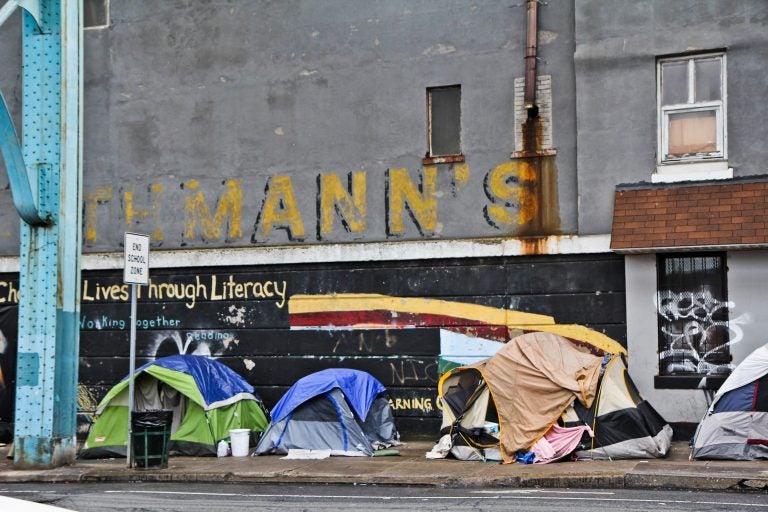Report finds Kensington homeless encampments not just a symptom of opioid crisis
A survey included in the Penn study suggests that the Kensington encampments also reflected broader issues that lead to homelessness.

People living at the encampment at Kensington Avenue. (Kimberly Paynter/WHYY)
A report from the University of Pennsylvania appraises Philadelphia’s work to close homeless encampments near the epicenter of the city’s opioid crisis in Kensington.
Under its “encampment resolution pilot,” the city mounted intensive outreach efforts to place encampment residents into treatment and housing services, and closed the last of four encampments under bridges in Kensington at the end of January.
The Penn report covers only the work to clear the first two bridges — one at Kensington Avenue and another at Tulip Street — that was completed last May.
It also includes a survey of people living under those bridges. Among the findings were that three-quarters of those surveyed struggled with opioid use, and that 40 percent had been homeless for more than a year. That, the researchers said, suggests that the encampments were not just products of the opioid crisis, but also of broader issues that lead to homelessness.
“This was much more than expected, a homeless population. This was not a group that just basically said, ‘We’re going to come to Kensington because there’s lots of drugs here,’ ” said Stephen Metraux, an associate professor at the University of Delaware’s Biden School of Public Policy and Administration who led the study. (Other researchers were affiliated with the University of Pennsylvania.)
The survey also found that the majority of people living in the encampments were from Philadelphia, challenging the perceptions of some neighborhood residents that the bridges were filled with people drawn from faraway places by easy access to drugs.
Metraux praised the city for lowering barriers to services and coordinating an array of agencies to address the twin problems of homelessness and addiction. This coordination, the report noted, would later form the basis of the Philadelphia Resilience Project, the Kenney administration’s emergency response to the opioid crisis.
“I think where [the city] fell short was that these are two very enormous problems,” Metraux said, “with very limited resources.”
The report found that, as of October, only about one in five people with whom outreach workers engaged in or around the underpasses at Kensington Avenue and Tulip Street had found a place in supportive or permanent housing programs. Metraux said the limited supply of housing will remain a barrier for addressing the still-widespread problem of homelessness in Kensington.
Philadelphia homeless-services director Liz Hersh said she agreed the city needs more long-term housing opportunities, but this kind of support isn’t necessary for everyone who is homeless and addicted to opioids. Some become self-sufficient once they get treatment for addiction, she said.
“Sometimes, people can reunite with family; sometimes, they can get jobs,” Hersh said. “We don’t want to presume a lifetime of dependency.”
Kenney’s budget proposal for next year calls for $5 million in additional funding toward housing supports for the Resilience Project.
The Penn report also noted that opening more beds for temporary shelter in Kensington could have gotten more people from the encampments off the street. It said community opposition was a barrier to expanding local shelter capacity. City officials later tried but failed to bring a new shelter for people in addiction to Kensington, arguing that it needed to be closer to where they were concentrated — and their source of drugs — for it to be a more appealing option than staying under a bridge.
“One of the toughest challenges that the city had was to balance the needs of community and the interests of the people who were homeless,” Metraux said. “A lot of times, those interests, those needs, conflicted.”
WHYY is your source for fact-based, in-depth journalism and information. As a nonprofit organization, we rely on financial support from readers like you. Please give today.





